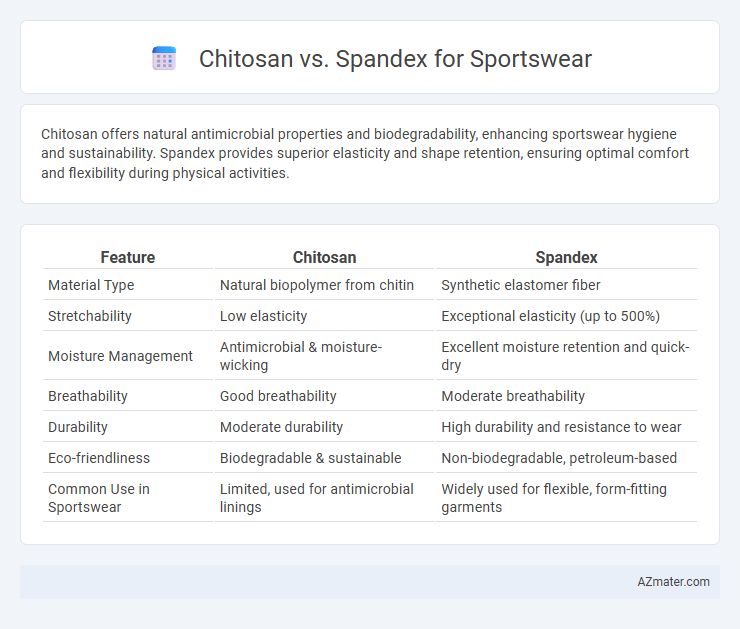Chitosan offers natural antimicrobial properties and biodegradability, enhancing sportswear hygiene and sustainability. Spandex provides superior elasticity and shape retention, ensuring optimal comfort and flexibility during physical activities.
Table of Comparison
| Feature | Chitosan | Spandex |
|---|---|---|
| Material Type | Natural biopolymer from chitin | Synthetic elastomer fiber |
| Stretchability | Low elasticity | Exceptional elasticity (up to 500%) |
| Moisture Management | Antimicrobial & moisture-wicking | Excellent moisture retention and quick-dry |
| Breathability | Good breathability | Moderate breathability |
| Durability | Moderate durability | High durability and resistance to wear |
| Eco-friendliness | Biodegradable & sustainable | Non-biodegradable, petroleum-based |
| Common Use in Sportswear | Limited, used for antimicrobial linings | Widely used for flexible, form-fitting garments |
Introduction to Chitosan and Spandex
Chitosan, a natural biopolymer derived from chitin found in crustacean shells, offers antibacterial properties and moisture-wicking benefits ideal for sportswear. Spandex, a synthetic fiber known for exceptional elasticity, enhances comfort and freedom of movement in athletic apparel. Combining chitosan's antimicrobial qualities with spandex's stretchability creates high-performance fabrics optimized for activewear durability and hygiene.
Material Composition and Sources
Chitosan is a biopolymer derived from chitin found in crustacean shells, known for its natural antibacterial and moisture-wicking properties, making it ideal for sportswear focused on hygiene and breathability. Spandex, a synthetic fiber composed of polyurethane, offers exceptional elasticity and shape retention, commonly used to provide stretch and comfort in activewear. Combining chitosan's biodegradable, renewable source with spandex's synthetic flexibility can enhance sportswear performance by balancing sustainability and functionality.
Moisture Management and Breathability
Chitosan fibers exhibit superior moisture management due to their natural hydrophilic properties, effectively absorbing and releasing sweat, which enhances breathability in sportswear. In contrast, Spandex offers excellent elasticity but lacks inherent moisture-wicking capability, often requiring blending with other fibers to improve ventilation. Combining Chitosan with Spandex can create fabric that balances stretch with effective moisture control, ideal for high-performance athletic apparel.
Comfort and Fit in Sportswear
Chitosan fibers in sportswear offer superior moisture-wicking and antibacterial properties, enhancing comfort by reducing odor and maintaining dryness during intense activities. Spandex is renowned for its exceptional elasticity and stretchability, providing a snug fit that supports a wide range of motion without restricting movement. Combining Chitosan's natural breathability with Spandex's flexibility results in sportswear that balances comfort and fit, optimizing performance and wearability.
Durability and Longevity Comparison
Chitosan fibers exhibit high durability due to their natural antimicrobial properties and resistance to wear, making them ideal for long-lasting sportswear that maintains freshness. Spandex offers excellent elasticity and shape retention, but may degrade faster under intense physical activity and frequent washing compared to chitosan. Overall, chitosan sportswear provides superior longevity, especially in moisture-rich environments, while spandex excels in stretch performance but requires careful maintenance to extend durability.
Antibacterial and Odor-Resistant Properties
Chitosan fibers exhibit strong antibacterial properties due to their natural positive charge, which disrupts microbial cell membranes, making them highly effective in sportswear for minimizing odor and bacteria buildup. Spandex, while prized for its elasticity and fit, lacks inherent antimicrobial qualities, often requiring chemical treatments to achieve similar odor-resistant effects. Integrating chitosan into sportswear enhances hygiene and durability by providing a sustainable, antimicrobial barrier that reduces sweat-induced odors more efficiently than conventional spandex blends.
Environmental Impact and Sustainability
Chitosan fibers, derived from chitin found in crustacean shells, offer significant environmental benefits due to their biodegradability and renewable sourcing, reducing microplastic pollution associated with synthetic fibers like spandex. Spandex, a petroleum-based elastane, poses sustainability challenges because of its non-biodegradable nature and energy-intensive manufacturing process, contributing to environmental degradation. Choosing chitosan for sportswear supports eco-friendly practices by promoting waste valorization and reducing reliance on fossil fuels, aligning with sustainable textile industry goals.
Performance in High-Intensity Activities
Chitosan offers antimicrobial properties and moisture-wicking capabilities that help maintain freshness and reduce odor during high-intensity activities, enhancing comfort and hygiene. Spandex provides exceptional elasticity and shape retention, allowing for unrestricted movement and superior support under dynamic conditions. Combining these materials can optimize sportswear performance by balancing antimicrobial benefits with flexibility and durability.
Cost and Market Availability
Chitosan-based sportswear tends to be more expensive due to its natural origin and specialized biomedical properties, limiting its widespread market availability compared to spandex. Spandex, or elastane, offers a cost-effective and highly accessible option, dominating the sportswear market due to mass production and established supply chains. Cost efficiency and widespread availability make spandex the preferred choice for most manufacturers, while chitosan remains niche with premium pricing.
Future Trends in Sportswear Fabrics
Chitosan-infused sportswear is gaining traction due to its natural antibacterial properties, biodegradability, and moisture-wicking capabilities, presenting a sustainable alternative to synthetic fibers like spandex. Innovations in bio-based chitosan fibers are expected to enhance elasticity and durability, matching or surpassing spandex's stretch and recovery performance. Future trends indicate a shift towards eco-friendly, high-performance fabrics that combine chitosan's antimicrobial benefits with advanced spandex blends for optimal comfort and environmental impact.

Infographic: Chitosan vs Spandex for Sportswear
 azmater.com
azmater.com